1998 CHEVROLET CAVALIER oil filter
[x] Cancel search: oil filterPage 274 of 400
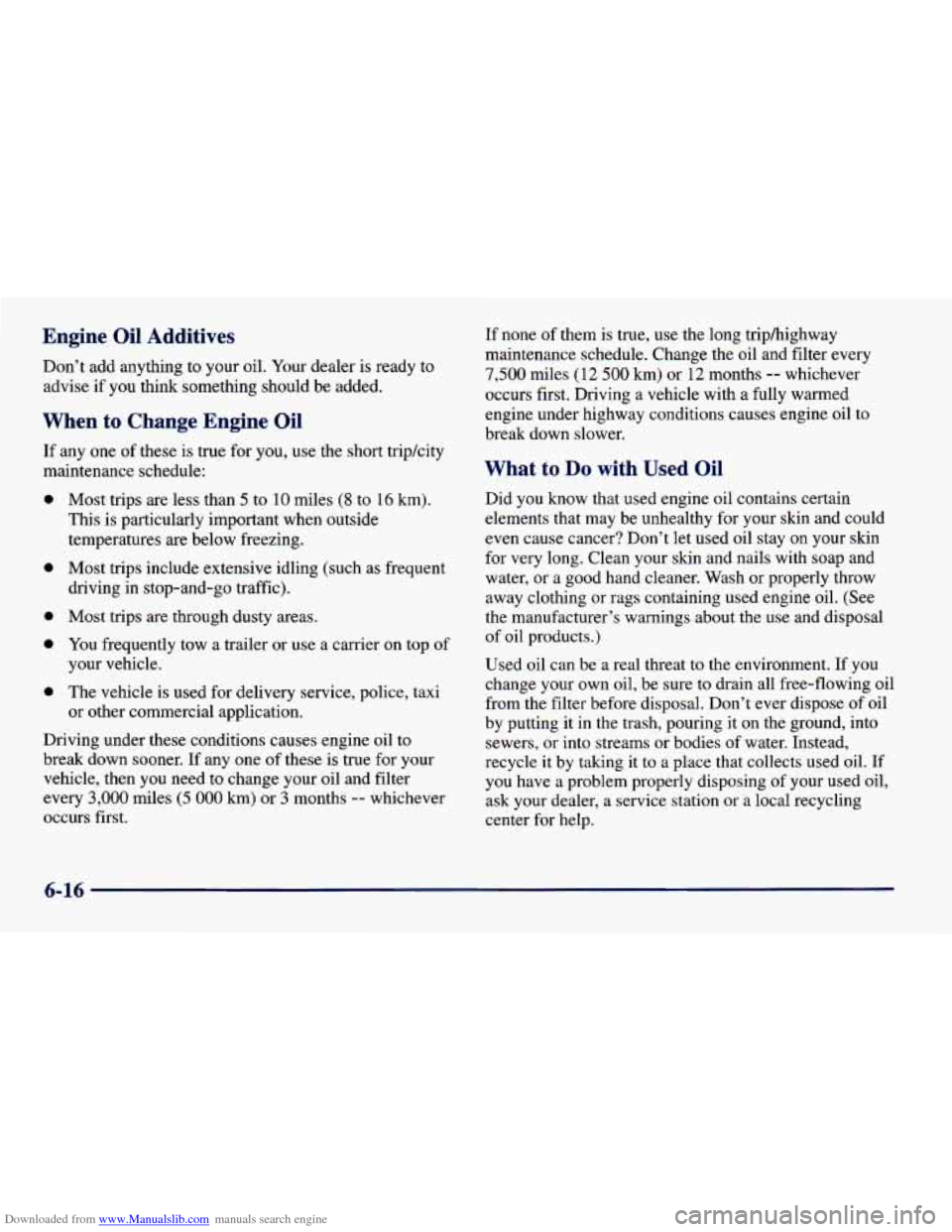
Downloaded from www.Manualslib.com manuals search engine Engine Oil Additives
Don’t add anything to your oil. Your dealer is ready to
advise
if you think something should be added.
When to Change Engine Oil
If any one of these is true for you, use the short tripkity
maintenance schedule:
e
e
0
0
e
Most trips are less than 5 to 10 miles (8 to 16 km).
This
is particularly important when outside
temperatures are below freezing.
Most trips include extensive idling (such as frequent
driving in stop-and-go traffic).
Most trips
are through dusty areas.
You frequently tow a trailer
or use a carrier on top of
your vehicle.
The vehicle is used for delivery service, police, taxi
or other commercial application.
Driving under these conditions causes engine oil
to
break down sooner. If any one of these is true for your
vehicle, then you need
to change your oil and filter
every
3,000 miles (5 000 km) or 3 months -- whichever
occurs first.
If none of them is true, use the long triphighway
maintenance schedule. Change the oil and filter every
7,500 miles (12 500 km) or 12 months -- whichever
occurs first. Driving a vehicle with a fully warmed
engine under highway conditions causes engine oil to
break down slower.
Wh .~: 1 I Do with Used Oil
Did you know that used engine oil contains certain
elements that may be unhealthy for your skin and could
even cause cancer? Don’t let used
oil stay on your skin
for very long. Clean your
skin and nails with soap and
water, or a good hand cleaner. Wash
or properly throw
away clothing
or rags containing used engine oil. (See
the manufacturer’s warnings about the use and disposal
of oil products.)
Used oil can be a real threat to the environment. If you
change your own oil, be sure
to drain all free-flowing oil
from the filter before disposal. Don’t ever dispose of
oil
by putting it in the trash, pouring it on the ground, into
sewers, or into streams or bodies of water. Instead,
recycle it by taking
it to a place that collects used oil. If
you have a problem properly disposing of your used oil,
ask your dealer, a service station or a local recycling
center for help.
6-16
Page 276 of 400
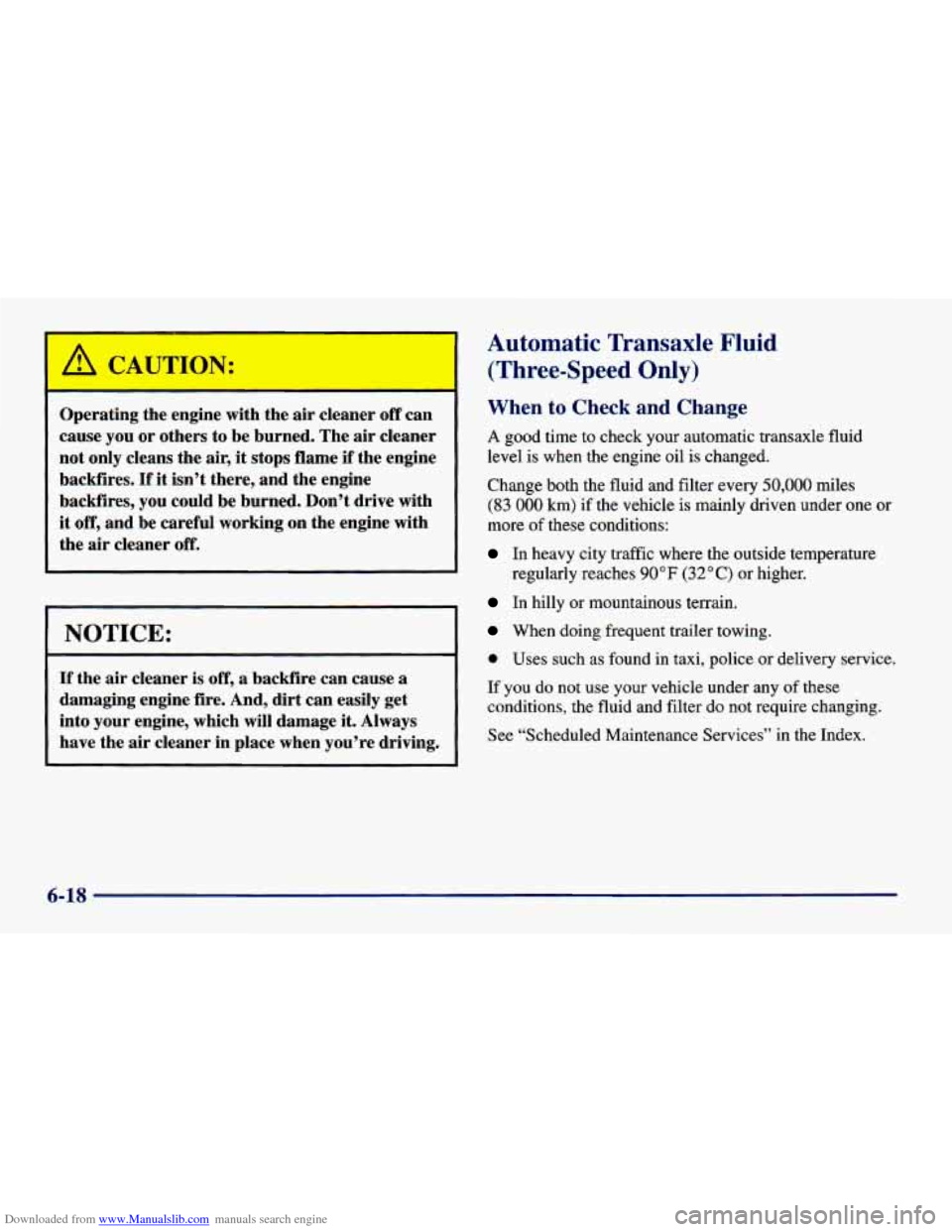
Downloaded from www.Manualslib.com manuals search engine Operating the engine with the air cleaner off can
cause you or others to be burned. The air cleaner
not only cleans the air, it stops flame
if the engine
backfires.
If it isn’t there, and the engine
backfires, you could be burned. Don’t drive with
it
off, and be careful working on the engine with
the air cleaner
off.
NOTICE:
If the air cleaner is off, a backfire can cause a
damaging engine fire. And, dirt can easily get
into your engine, which will damage it.
Always
have the air cleaner in place when you’re driving.
Automatic Transaxle Fluid
(Three-Speed Only)
When to Check and Change
A good time to check your automatic transaxle fluid
level is when the engine oil is changed.
Change both the fluid and filter every
50,000 miles
(83 000 km) if the vehicle is mainly driven under one or
more of these conditions:
In heavy city traffic where the outside temperature
In hilly or mountainous terrain.
When doing frequent trailer towing.
0 Uses such as found in taxi, police or delivery service.
If you do not use your vehicle under any of these
conditions, the fluid and filter do not require changing.
See “Scheduled Maintenance Services’’ in the Index. regularly reaches
90°F (32°C)
or higher.
6-18
Page 279 of 400
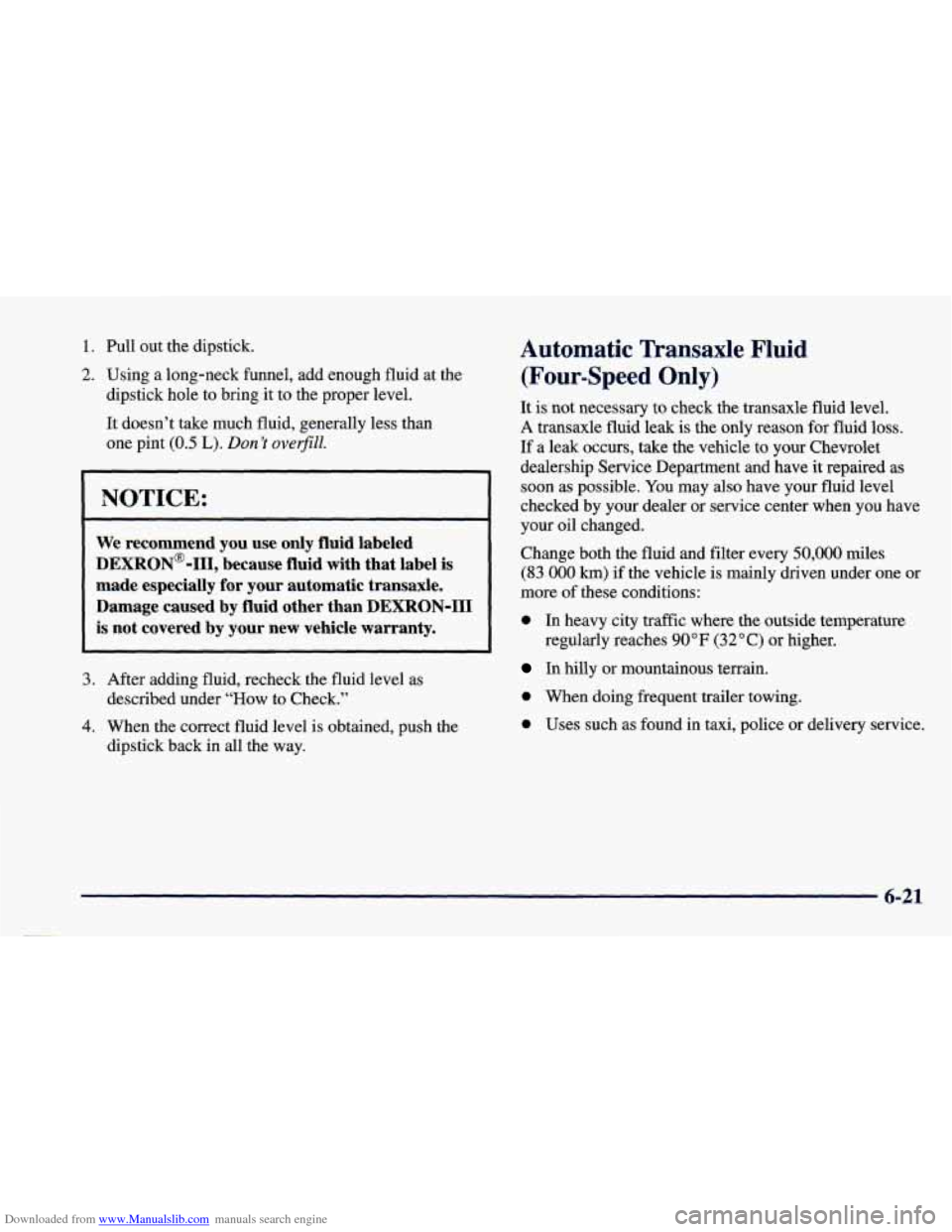
Downloaded from www.Manualslib.com manuals search engine 1. Pull out the dipstick. Automatic Transaxle Fluid
2. Using a long-neck funnel, add enough fluid at the (Four-Speed Only) dipstick hole to bring it to the proper level.
It doesn’t take much fluid, generally less than A transaxle \
fluid leak
is the only reason for fluid loss.
one pint
(0.5 L). Don’t ove$ZZ. If a leak occurs, take the vehicle to your Chevrolet
dealership Service Department and have it repaired as
soon as possible. You may also have your fluid level
checked by your dealer or service center when you have your oil changed.
Change both the fluid and filter every
50,000 miles
(83 000 km) if the vehicle is mainly driven under one or
more of these conditions:
0 In heavy city traffic where the outside temperature
In hilly or mountainous terrain.
It
is not necessary
to check the transaxle fluid level.
NOTICE:
We recommend you use only fluid labeled
DEXRON@-III, because fluid with that label is
made especially for your automatic transaxle.
Damage caused by fluid other than DEXRON-I11
is not covered by your new vehicle warranty. regularly reaches 90 OF (32 O C) or higher.
3. After adding fluid, recheck the fluid level as described under “How to Check.”
0 When doing frequent trailer towing.
4. When the correct fluid level is obtained, push the dipstick back in all the way. 0 Uses such as found in taxi, police or delivery service.
6-21
Page 280 of 400
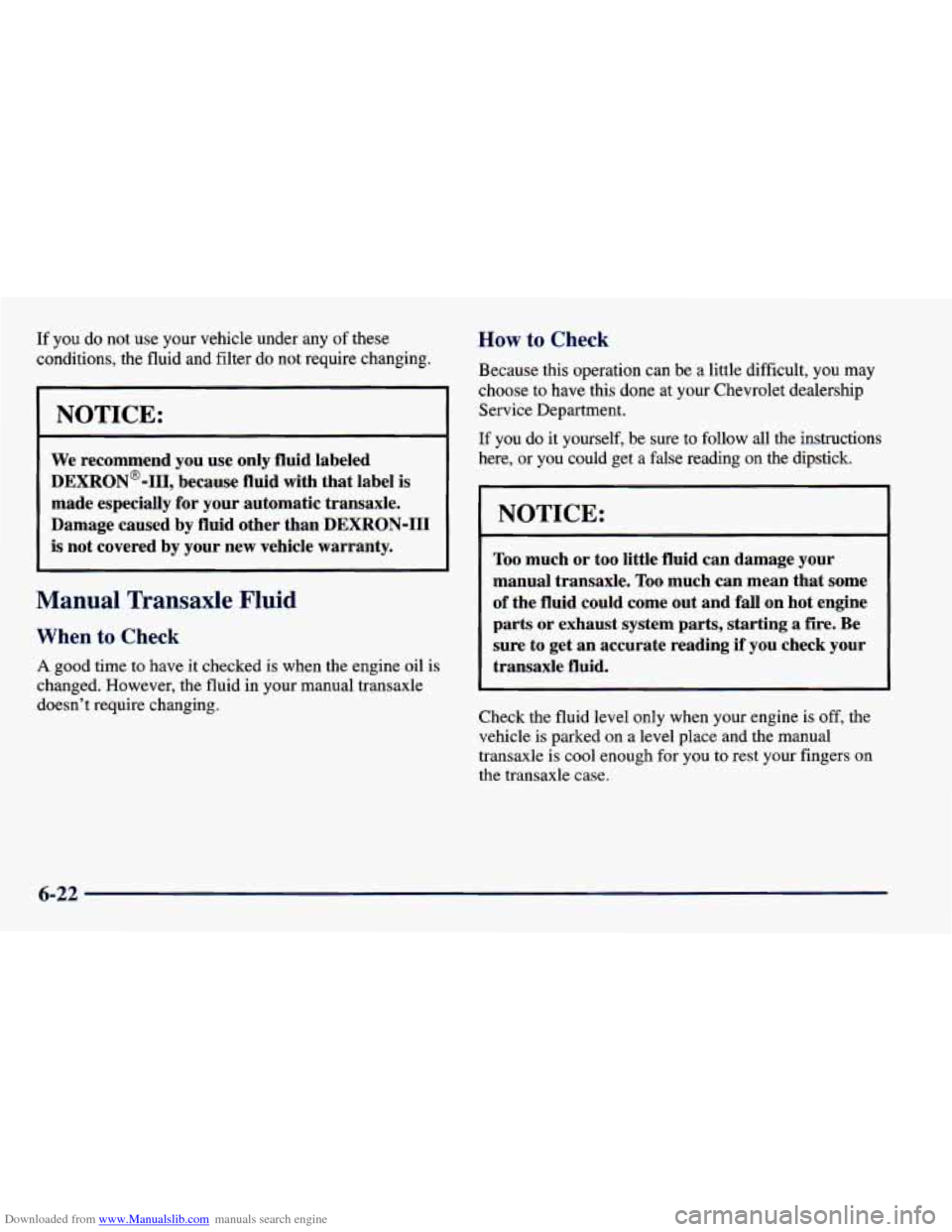
Downloaded from www.Manualslib.com manuals search engine If you do nor use your vehicle under any of these
conditions, the fluid and filter do not require changing.
NOTICE:
We recommend you use only fluid labeled
DEXR0N'-111, because fluid with that label is
made especially for your automatic transaxle.
Damage caused by fluid other than DEXRON-I11
is not covered by your new vehicle warranty.
Manual Transaxle Fluid
When to Check
A good time to have it checked is when the engine oil is
changed. However, the fluid in your manual transaxle
doesn't require changing.
How to Check
Because this operation can be a little difficult, you may
choose to have this done at your Chevrolet dealership
Service Department.
If you do it yourself, be sure to follow all the instructions
here, or you could get a false reading on the dipstick.
ITICE:
Too much or too little fluid can damage your
manual transaxle.
Too much can mean that some
of the fluid could come out and fall on hot engine
1 parts or exhaust system parts, starting a fire. Be
sure to get an accurate reading if you check your
transaxle fluid.
Check the fluid level only when your engine is off, the
vehicle
is parked on a level place and the manual
transaxle is cool enough for
you to rest your fingers on
the transaxle case.
6-22
Page 322 of 400

Downloaded from www.Manualslib.com manuals search engine Refrigerant (R=134a), Air Conditioning
.............. See refrigerant
charge label under hood.
Fuel Tank ................. 15.2 gallons (57.5 L)
Tire Pressures, Sizes ........... See Tire-Loading Information label on driver’s door.
Wheel Nut Torque .......... 100 lb-ft (140 Nmm)
NOTE: All capacities are approximate. When adding, be
sure to fill to the appropriate level, as recommended in
this manual.
Air Conditioning Refrigerants
Not all air conditioning refrigerants are the same.
If the air conditioning system in your vehicle needs
refrigerant, be sure the proper refrigerant is used. If
you’re not sure, ask your dealer.
Normal Maintenance
Replacement Parts
Air Cleaner Element
2.2L ....................... AC Type A- 11 72C
Engine Oil Filter
2.2L .......................... AC Type PF-47
2.4L
.......................... AC Type PF-44
Spark Plugs
2.2L ......................... AC Type 41-948
Gap:
0.050 inch (1.27 mm)
2.4L
......................... AC Type 4 1-942
Gap: 0.050 inch (1.27 mrn)
Windshield Wiper Blade (Sheppard’s Hook vpe)
Left Side ..................... 22 inches (56 cm)
Right Side.
................... 17 inches (43 cm)
2.4L
....................... AC Type A- 1172C
6-64
Page 331 of 400
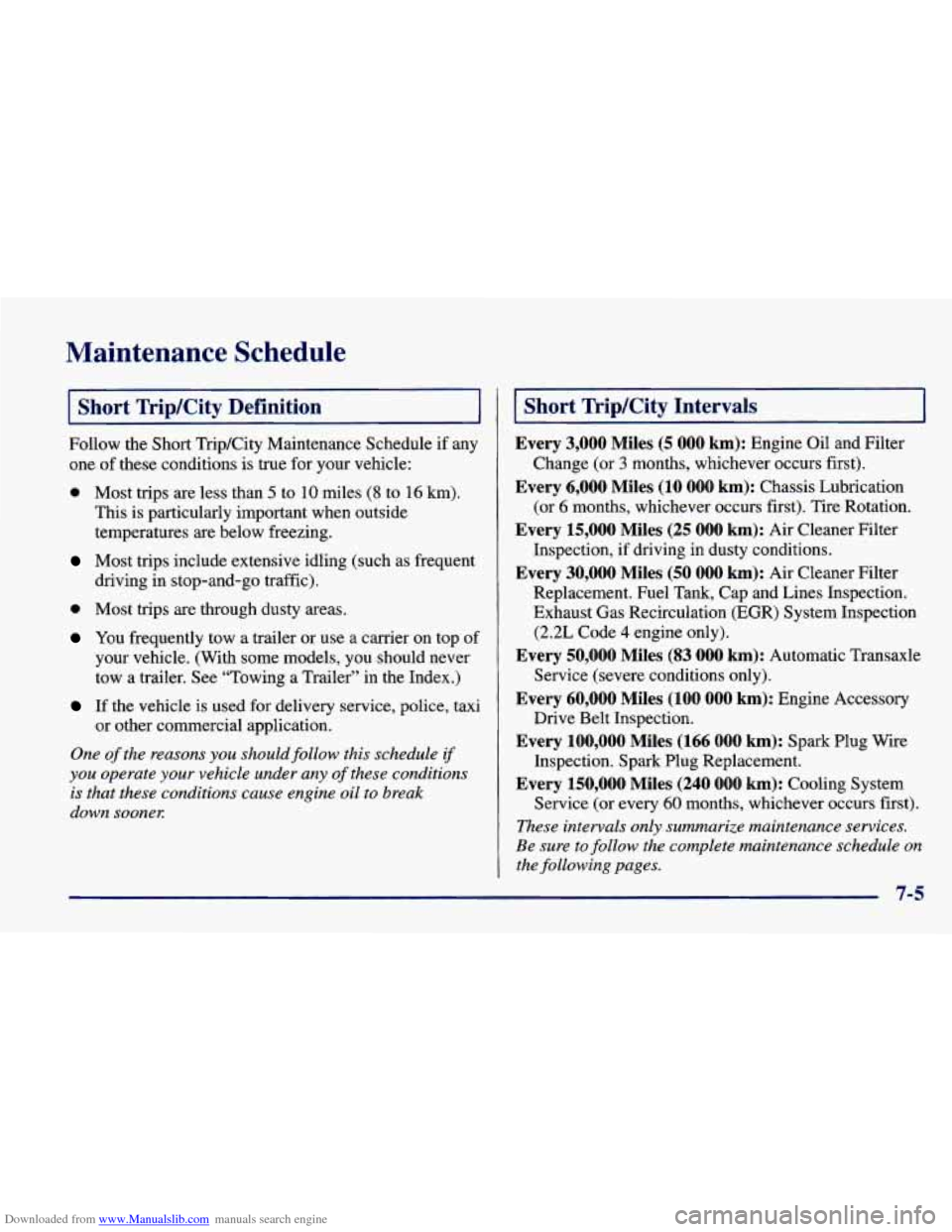
Downloaded from www.Manualslib.com manuals search engine Maintenance Schedule
-G/City Definition
Follow the Short TripKity Maintenance Schedule if any
one of these conditions is true for your vehicle:
0 Most trips are less than 5 to 10 miles (8 to 16 km).
This is particularly important when outside
temperatures are below freezing.
driving in stop-and-go traffic).
Most trips include extensive idling (such as frequent
0 Most trips are through dusty areas.
You frequently tow a trailer or use a carrier on top of
your vehicle. (With some models, you should never
tow a trailer. See “Towing a Trailer” in the Index.)
If the vehicle is used for delivery service, police, taxi
One of the reasons you should follow this schedule if
you operate your vehicle under any of these conditions
is that these conditions cause engine oil to break
down soonex
or other commercial application.
Short Trip/City Intervals
Every 3,000 Miles (5 000 km): Engine Oil and Filter
Every 6,000 Miles (10 000 km): Chassis Lubrication
Every 15,000 Miles (25 000 km): Air Cleaner Filter
Every 30,000 Miles (50 000 km): Air Cleaner Filter
Change (or
3 months, whichever occurs first).
(or
6 months, whichever occurs first). Tire Rotation.
Inspection, if driving in dusty conditions.
Replacement. Fuel Tank, Cap and Lines Inspection. Exhaust Gas Recirculation (EGR) System Inspection (2.2L Code
4 engine only).
Every 50,000 Miles (83 000 km): Automatic Transaxle
Service (severe conditions only).
Every 60,000 Miles (100 000 km): Engine Accessory
Drive Belt Inspection.
Every 100,000 Miles (166 000 km): Spark Plug Wire
Inspection. Spark Plug Replacement.
Every 150,000 Miles (240 000 km): Cooling System
Service (or every
60 months, whichever occurs first).
These intervals only summarize maintenance services.
Be sure to follow the complete maintenance schedule
on
the following pages.
7-5
Page 332 of 400
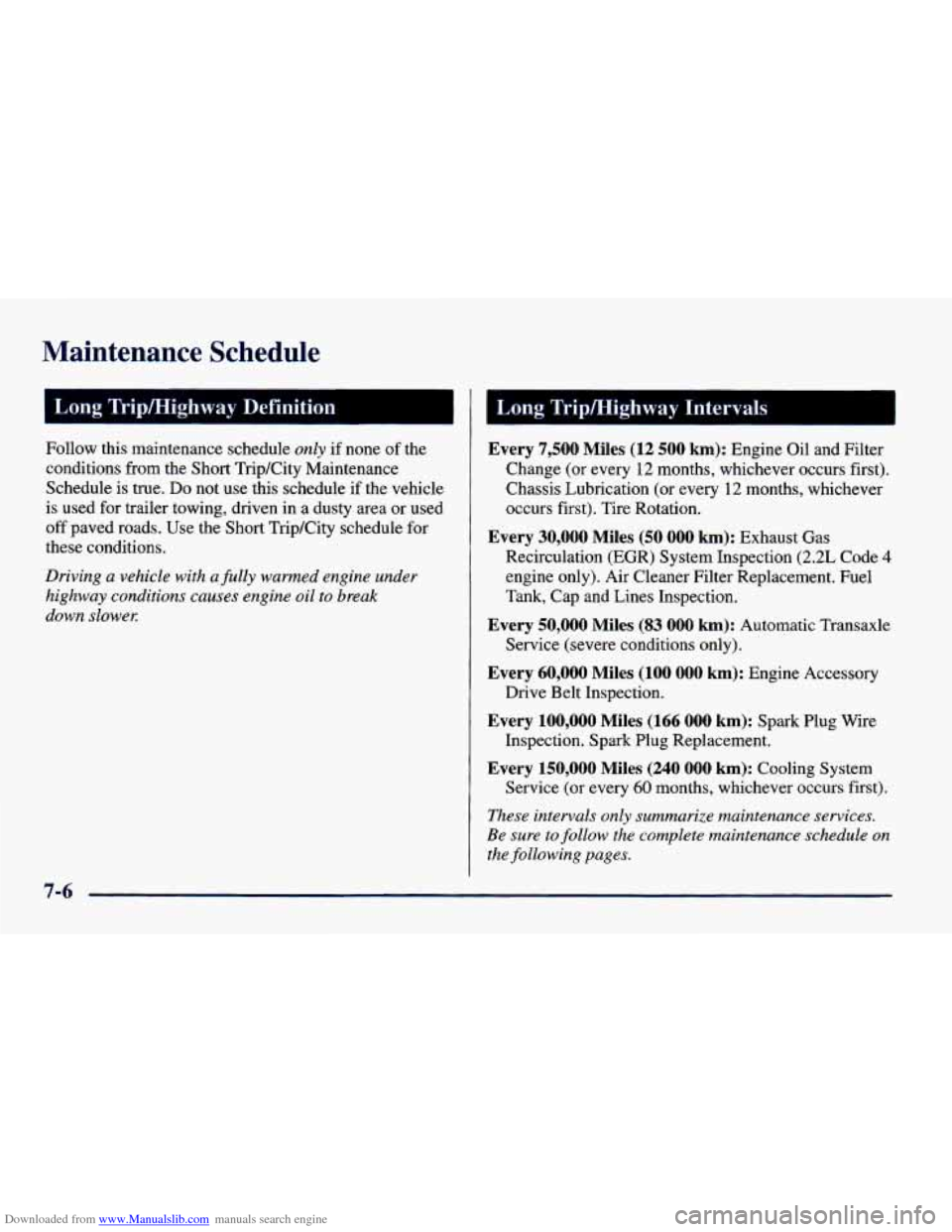
Downloaded from www.Manualslib.com manuals search engine Maintenance Schedule
1 Long Trip/Highway Definition
Follow this maintenance schedule only if none of the
conditions from the Short TripKity Maintenance
Schedule is
true. Do not use this schedule if the vehicle
is used for trailer towing, driven in a dusty area or used
off paved roads. Use the Short TripKity schedule for
these conditions.
Driving a vehicle with a fully warmed engine under
highway conditions causes engine oil to break
down slowel:
7-6
Long Trip/Highway Intervals - -
Every 7,500 Miles (12 500 km): Engine Oil and Filter
Change
(or every 12 months, whichever occurs first).
Chassis Lubrication (or every
12 months, whichever
occurs first). Tire Rotation.
Every 30,000 Miles (50 000 km): Exhaust Gas
Recirculation (EGR) System Inspection
(2.2L Code 4
engine only). Air Cleaner Filter Replacement. Fuel
Tank, Cap and Lines Inspection.
Every 50,000 Miles (83 000 km): Automatic Transaxle
Service (severe conditions only).
Every 60,000 Miles (100 000 km): Engine Accessory
Drive Belt Inspection.
Every 100,000 Miles (166 000 km): Spark Plug Wire
Inspection. Spark Plug Replacement.
Every 150,000 Miles (240 000 km): Cooling System
These intervals only summarize maintenance services.
Be sure to follow the complete maintenance schedule
on
the following pages.
Service (or every 60 months, whichever occurs first).
Page 334 of 400
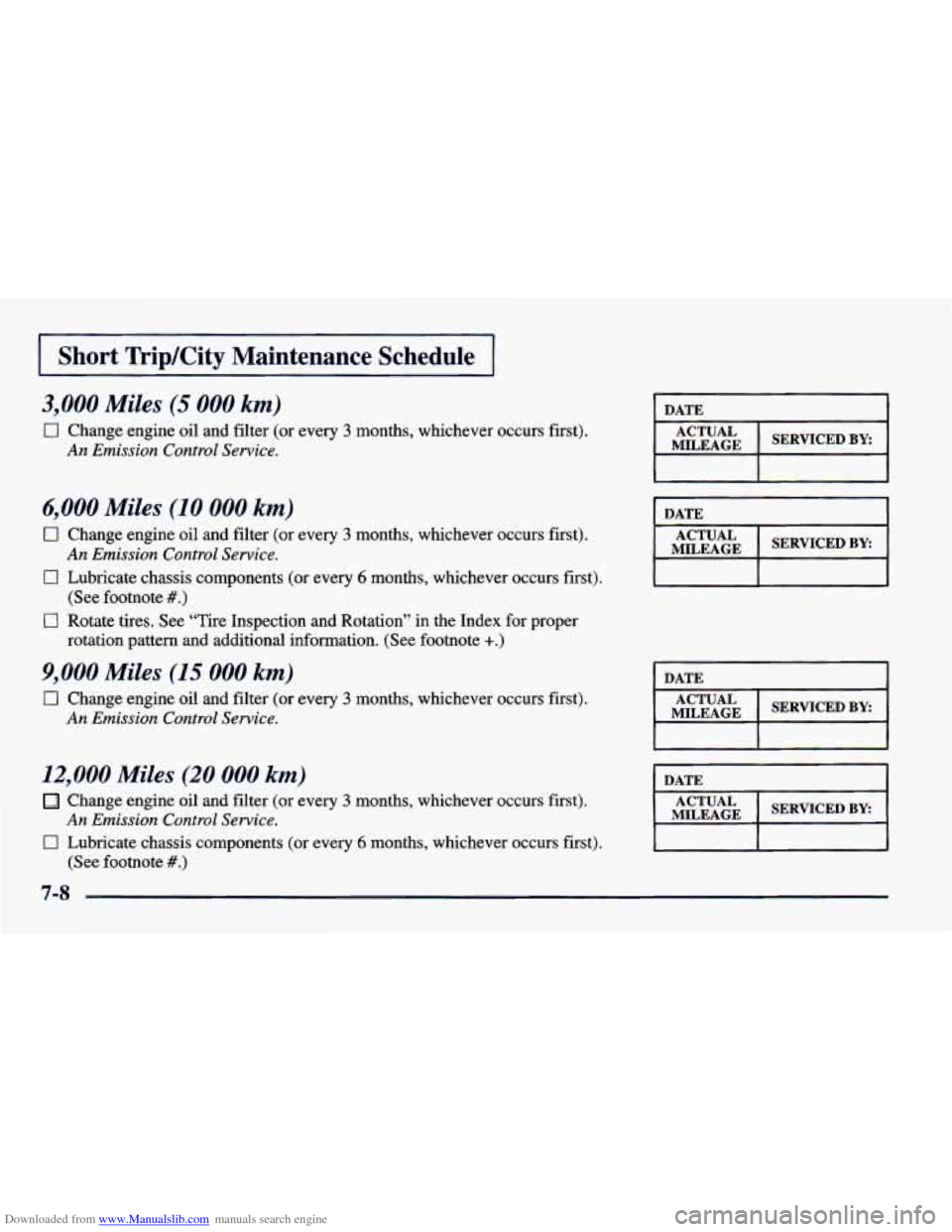
Downloaded from www.Manualslib.com manuals search engine 1 Short TripKity Maintenance Schedule I
3,000 Miles (5 000 km)
0 Change engine oil and filter (or every 3 months, whichever occurs first).
An Emission Control Service.
6,000 Miles (10 000 km)
0 Change engine oil and filter (or every 3 months, whichever occurs first).
0 Lubricate chassis components (or every 6 months, whichever occurs first).
0 Rotate tires. See “Tire Inspection and Rotation” in the Index for proper
An Emission Control Service.
(See footnote #.)
rotation pattern and additional information. (See footnote +.)
9,000 Miles (15 000 km)
0 Change engine oil and filter (or every 3 months, whichever occurs first).
An Emission Control Service.
I DATE I
I DATE
I MILEAGE I SERVICEDBY: I
AL I UNL
DATE I
SERVICED BY:
12,000 Miles (20 000 km)
Change engine oil and filter (or every 3 months, whichever occurs first).
17 Lubricate chassis components (or every 6 months, whichever occurs first).
7-8
An Emission Control Service,
(See footnote #.)